
During our research into different habits of visualising peace, our team started thinking about how we might represent peace ourselves. It is one thing to analyse how other people narrate, depict, understand and communicate it – but what kinds of decisions would we take when trying to visualise peace for others? As an experiment, we decided to commission a local artist – Zofia Guertin, aka Archeoartist – to create a banner for our project, incorporating different aspects of peace and peace-making that we particularly wanted to highlight.
One thing we learnt during this process was how difficult it can be to move away from traditional symbols of peace while still trying to communicate a widely recognisable idea of peace to others. Mindful of our Western bias, we thought critically about how the symbolism of the poppy (for example) might resonate in other parts of the world. We tried to incorporate imagery that evoked some specific conflicts (WWI, Cyprus, Iraq, Ukraine) while being inclusive of all and not aligning our artwork with any particular culture or religion. Peace is not always defined in relation to conflict, but we wanted to retain echoes of conflict in our banner (via the white feather, and the UN peace-keeper’s helmet) to avoid a purely utopian vision of peace.
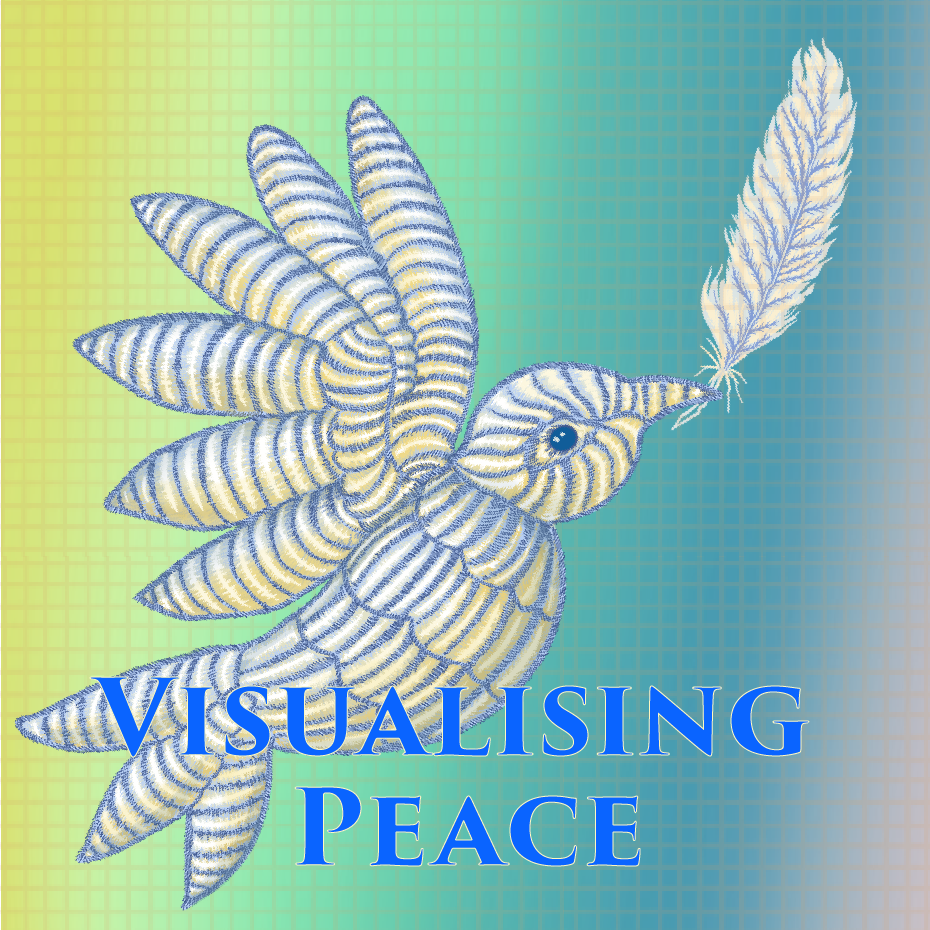
The dove is an iconic image of peace. But this one is holding a white feather, not an olive branch. The white feather evokes both the conscientious objectors of WWI and the hostility they were often met with for refusing to fight. Our dove does not idealise peace as a concept that is universally celebrated. Instead, it reminds us that pacifists are sometimes met with derision and aggression, while soldiers are heroized. Our dove carries in its beak a sign of the struggles and stigma that anti-war campaigners have often encountered and a reminder of the paradox that our desire for peace does not always extend to support for pacifists.
In the UK, red poppies are often worn in the lead-up to Armistice Day (11th November), to commemorate the end of WWI and to remember all who have died as a result of conflict. The poppy was chosen as a flower of remembrance because it was one of the first signs of life to spring up in the WWI battlefields of France after the fighting stopped.[i] It evokes a coming back to life after the bloodshed of war, but its red petals are also a poignant reminder of the many lives lost. For many, the poppy is more a reminder of war than a symbol of peace; so some choose to wear white poppies around Remembrance Day, to call for peace rather than commemorating conflict.[ii] That is why we added in a white ‘peace lily’ to sit in front of the poppy in our banner.
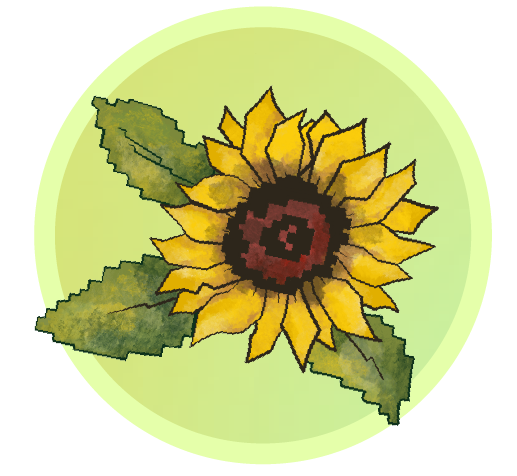
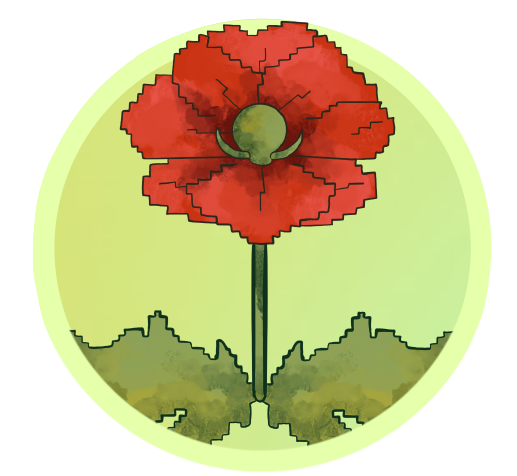
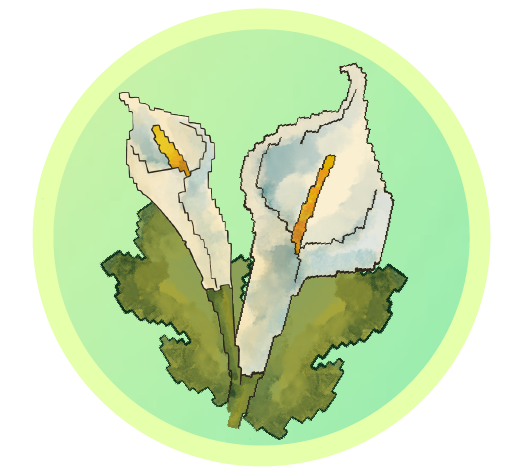
In different parts of the world, different flowers can symbolise peace. Sunflowers have not traditionally been associated with peace, but we had several reasons for wanting to include them in our banner. The bright yellow of the sunflower evokes sunshine after clouds. Its seeds remind us of the cycle of life. Not only do the eye-catching spirals of seeds in a sunflower promise hundreds more sunflowers to come; they also provide nourishment to birds, animals and even humans. As a flower that is farmed for the oil that its seeds produce, the sunflower evokes both nature and agriculture, and this was important to us. While natural imagery can be evocative when representing peace (‘sowing seeds of peace’, ‘peace flourishing’, ‘grassroots peace-making’, etc), we wanted our banner to reflect that fact that peace has to be worked for by people. It does not spring fully formed from the ground. Sitting next to wild poppies and cultivated lilies, the sunflowers in our banner underline the human effort in promoting and sustaining peace.
In 2022, the sunflower also has particular resonance, as Ukraine’s national flower. Since Russia’s full-scale invasion of Ukraine in February 2022, the sunflower has become a symbol of Ukrainian resistance, and many people around the world have been displaying, sharing and growing sunflowers to show their support of the people of Ukraine. The war in Ukraine is disrupting farming across the country, and the impacts of on the production not only of sunflower oil but also of wheat, maize and barley will cause food shortages all around the world. Our need for peace can be visualised as a need for more sunflowers.
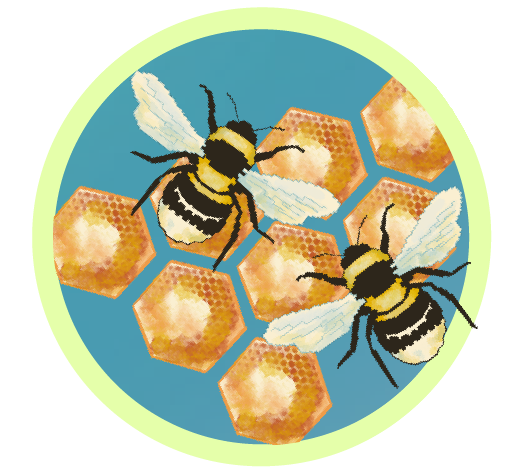
As noted above, when we think of peace, images of abundant nature often come to mind. We decided to include bees and their honeycomb in our Visualising Peace banner because they evoke a thriving natural environment, but also because bees are highly social creatures and can only create honey by working together. Peace may taste sweet, but it does not arise spontaneously: it has to be crafted by many different parts of a community in co-operation. It is hard work, and it has to be nurtured every day. Not by a single ruler or a powerful clique but by the whole colony, with all members playing a part – not least women.
The bees and their honeycomb in our banner represent that general principle, but they also evoke a particular story of post-conflict recovery: the story of Mosul, as told by Emily Mayhew in her book The Four Horsemen and the Hope of a New Age. Mayhew’s discussion builds on the observations of historian and blogger Dr Omar Mohammed – aka Mosul Eye – who identified the return of beekeepers and their hives after the liberation of Mosul in 2017/18 as a sign of the return of more peaceful times. As Mayhew put it:
The sight of the jars of honey meant many things. It meant that the agricultural ecosystem was being restored, despite the destruction and the oil spills and the toxic remnants of occupation and the blood of liberation. The land was recovering enough to support plants that could support bee colonies, and the natural farming cycle of Nineveh was back in the hands of people who respected it. It meant the sounds of the city had returned to a steady noisy normal, without explosions or heavy vehicles thundering by, so bees flew without fear, and the keepers tended them without fear during the day. The bees will need care. Water supplies are still low and this could affect crop yields. But Mosul bees are tough. Wherever they fled to during the war, they survived somehow and then they came back, unstressed enough to make record amounts of honey, and livings for many. Hope in a jar, in yogurt, in tea, licked from a spoon by a child who had perhaps never known what sweetness really meant before that moment.
Mayhew, The Four Horsemen and the Hope of a New Age, 2021: pp. 240-241
Emily Mayhew’s book discusses all the people who stand in line against War and its fellow horsemen: Famine, Pestilence and Death. When we think of the people involved in building or maintaining peace, our thoughts often turn to UN Peacekeepers and to politicians who negotiate peace treaties. But ‘top-down’ peace-building is often less sustainable than more inclusive ‘bottom-up’ peace-building that involves all members of the affected communities, including women and young people.[iii] That is why our banner features a range of ordinary people, from different parts of the world, alongside more iconic images of peace. Children are there for a reason. They are the peacekeepers of the future, and as organisations like Never Such Innocence have shown, children’s views on conflict and its resolution are worth listening to.[iv]

The colour palette in our banner goes from dark to light, and light to dark. We wanted to evoke bright skies and blue helmets, but also the ever-present threat of war with more sober shades. We were struck in our research that in some parts of the world, a cloudy sky can promise a more peaceful day – because drones are harder to fly and easier to spot than with clear skies. Blue skies and sunshine do not mean the same thing to everyone, because we don’t all experience the same kinds of peace. You might also notice a ‘cross-stitch aesthetic to our banner. This is because we have been moved by the stories behind many ‘conflict textiles’, which not only narrate the horrors of war but also advocate for post-conflict justice and reconciliation.[v] The metaphor of peace-building as a work of collective stitching captures many things: mending, remaking, joining, embellishing. Peace can be a difficult needle to thread, but many hands together can create something beautiful and lasting.
What do you think?
- Do you have any feedback on our banner?
- Do some elements of the banner speak more to you of peace or peacebuilding than others?
- Are there elements missing which you would like to see us include?
- What imagery or symbolism would you include in a piece of artwork designed to represent peace or peacebuilding?
- What colour scheme or aesthetics would you go for?
- Can you think of a peace of artwork that already exists which you think really embodies what peace or peace-building ‘look like’?
If you enjoyed this item…
You might also enjoy ‘Peace through Movement‘, ‘Peace from Pieces‘, ‘Visualising Peace after Forced Displacement‘ and ‘Fractured Peace: a visual representation‘.
Alice König, April 2022
[i] This article offers a helpful history of the red poppy and its (often highly politicised) meaning: https://theconversation.com/wearing-the-poppy-has-always-been-a-political-act-heres-why-106489.
[ii] The Peace Pledge Union has promotes white poppies for remembrance, stating: ‘The white poppy stands for three things. They represent remembrance for all victims of war, a commitment to peace and a challenge to attempts to glamorise or celebrate war.’
[iii] These articles offer some helpful comparisons of ‘top-down’ and ‘bottom-up’ peace-building techniques: https://journals.sagepub.com/doi/abs/10.1177/0263395715622967 and https://peacesciencedigest.org/pitfalls-of-top-down-peacebuilding/. You can also listen to Dr Roddy Brett discussing grassroots/bottom-up peace-building in this podcast: https://www.buzzsprout.com/1717787/9909987.
[iv] Try browsing the poetry, art, speeches and songs in the winners booklets on Never Such Innocence’s website, for a flavour of the views that children and young people from all around the world want to share about war and its aftermath: https://www.neversuchinnocence.com/past-competitions.
[v] Here are one or two favourites from their collection: https://cain.ulster.ac.uk/conflicttextiles/search-quilts2/fulltextiles1/?id=4 and https://cain.ulster.ac.uk/conflicttextiles/search-quilts2/fulltextiles1/?id=157 and https://cain.ulster.ac.uk/conflicttextiles/search-quilts2/fulltextiles1/?id=10.